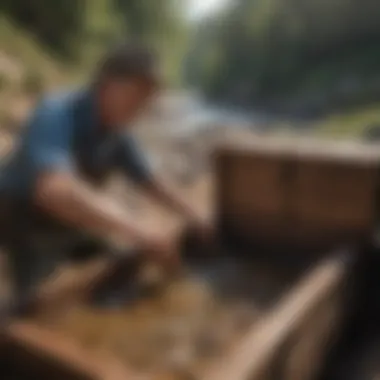Unlocking the Mysteries of Prospectors' Sluice Box Techniques: A Comprehensive Dive into the World of Mining Innovation


Rock and Fossil Identification
Exploring prospectors' techniques involves a keen understanding of various rocks and fossils. As prospectors venture into uncharted terrains, they must differentiate between different types of rocks, each with its unique characteristics and significance. Identifying rocks and fossils requires a trained eye to spot key features that hint at their geological origins. To aid in this meticulous process, prospectors depend on specialized tools meticulously crafted for accurate identification.
Collecting Tips and Techniques
Effective prospecting entails more than just identifying rocks and fossils; it extends to best practices for collecting these specimens. Prospectors need to employ strategic techniques for locating prime collecting sites rich in valuable ores. Moreover, extracting specimens safely is essential to preserve geological treasures without damage. This process entails a delicate balance of skill and caution to ensure successful retrieval while safeguarding specimens optimally.
Preservation and Display
Once collected, rocks and fossils require proper preservation to maintain their integrity and value. Prospectors must master various preservation techniques to prevent deterioration and prolong the lifespan of their precious finds. Equally important is the selection of appropriate storage methods to safeguard these specimens from environmental factors. Additionally, prospectors often showcase their treasures through creative display ideas that highlight the beauty and uniqueness of each geological specimen.
Geological Insights
Beyond the surface, exploring prospectors' techniques unveils profound geological insights. By delving into the geological formations and processes that shape our world, prospectors gain a deeper understanding of Earth's history. Moreover, the historical significance of rocks and fossils transcends mere scientific curiosity, offering glimpses into ancient ecosystems and evolutions. Notable discoveries in the field of geology serve as testaments to the invaluable contributions of prospectors throughout history.
Introduction to Prospecting
Prospecting plays a foundational role in unearthing valuable minerals and resources from the Earth's crust. The art of prospecting involves skilled individuals who employ a myriad of techniques to identify potential sites for exploration and mining. Understanding the prospector's craft is crucial as it sets the stage for successful resource extraction. Within this article, we delve deep into the nuances of prospecting, shedding light on the intricacies of prospectors' techniques and the tools they utilize to uncover hidden treasures.
Understanding the Prospector's Craft
Notable prospecting techniques
One of the cornerstone techniques in a prospector's toolkit is the meticulous art of sampling geological formations. By closely examining mineral deposits and rock formations, prospectors can pinpoint areas rich in minerals like gold, silver, or copper. This technique of sample analysis provides critical insights into the composition of an area, guiding prospectors towards promising sites for further exploration. The benefits of employing these methods lie in their ability to streamline the prospecting process, ultimately leading to more efficient resource discovery and extraction. Despite the manual labor involved, notable prospecting techniques remain a popular choice among prospectors due to their precision and reliability in identifying mineral-rich zones.


Evolution of prospecting tools
The evolution of prospecting tools has significantly enhanced the efficiency and accuracy of mineral prospecting endeavors. From humble picks and shovels to advanced geophysical equipment, the progression of tools has revolutionized the way prospectors navigate the rugged terrain in search of precious resources. Modern technologies such as drones and ground-penetrating radars have opened up new frontiers in prospecting, allowing prospectors to cover vast expanses of land quickly and intelligently. While these advancements offer undeniable advantages in terms of speed and coverage, they also bring about new challenges, such as the complexity of data interpretation and the high initial investment required. Yet, the evolution of prospecting tools stands as a testament to human ingenuity, driving the pursuit of mineral wealth to new heights.
Significance of Prospectors in History
Impact on exploration and discovery
Prospectors throughout history have played a pivotal role in expanding our knowledge of Earth's resources and geology. Their relentless exploration efforts have unlocked hidden treasures and paved the way for significant discoveries in the field of mining. By braving challenging terrains and harsh conditions, prospectors have unearthed valuable minerals that have fueled industrial growth and innovation. The impact of prospectors on exploration and discovery cannot be overstated, as their contributions have laid the foundation for modern mining practices and resource management.
Contributions to the mining industry
The contributions of prospectors to the mining industry are multifaceted and profound. Beyond the discovery of ore deposits, prospectors have been instrumental in developing sustainable mining practices and pioneering new extraction techniques. Their keen eye for geological formations and understanding of mineral behavior have led to advancements in ore processing and environmental stewardship within the mining sector. By bridging the gap between geological surveys and mining operations, prospectors have facilitated the efficient utilization of resources while minimizing environmental impact. Their contributions resonate throughout the mining industry, shaping the way we approach resource extraction and conservation.
Unveiling the Sluice Box
The focus of 'Unveiling the Sluice Box' within this article is crucial. The sluice box, an essential tool for prospectors, plays a significant role in the process of separating gold from other materials. Understanding the historical origins, design intricacies, and operational mechanics of the sluice box is paramount for any aspiring prospector.
Historical Origins of the Sluice Box
Invention and early adaptations
Exploring the inception and early adaptations of the sluice box reveals a fascinating evolution in prospecting technology. The initial designs and modifications aimed at optimizing the box for gold recovery revolutionized the efficiency of mining operations. The incorporation of innovative features and materials reshaped the way prospectors approached extracting valuable minerals. Despite some drawbacks in early renditions, the perseverance to refine the sluice box solidified its status as a go-to tool for prospectors.
Revolutionizing gold mining
The concept of revolutionizing gold mining through the sluice box marked a pivotal moment in the history of prospecting. By enhancing the effectiveness of separating gold from sediment, this advancement streamlined the mining process and increased yields significantly. The advent of this technology not only boosted the productivity of individual prospectors but also contributed to the overall growth of the mining industry as a whole. Its impact reverberated through time, setting a new standard in gold extraction methods.


Design and Components
Riffles and matting
The incorporation of riffles and matting in the sluice box design serves as a fundamental aspect of its functionality. These components create turbulence in the flowing water, efficiently trapping heavier materials like gold while allowing lighter debris to wash away. The strategic placement and spacing of riffles ensure optimal capture rates, maximizing the box's gold recovery capabilities. Despite variations in designs, riffles and matting remain integral elements that underline the efficiency of the sluice box.
Water flow and positioning
Balancing the water flow and positioning in a sluice box is critical for its operational success. Ensuring a consistent and controlled water flow aids in carrying away unwanted material, leaving behind the desired gold particles. Strategic positioning of the sluice box with respect to water sources and gradients optimizes the flow dynamics, enhancing the box's performance. Mastering these design aspects is paramount for prospectors seeking to optimize their gold recovery processes.
Operational Mechanics
Principles of gravity separation
The principles of gravity separation underpin the operational mechanics of a sluice box. By exploiting the differential densities of materials, gravity assists in segregating gold particles from lighter sediments. This natural phenomenon forms the basis of the sluice box operation, enabling the efficient recovery of gold through gravitational forces. Understanding this principle is essential for prospectors looking to harness the full potential of the sluice box in their mining endeavors.
Efficacy in capturing fine particles
The efficacy of a sluice box in capturing fine particles underscores its efficiency in gold recovery. Fine gold particles present a unique challenge due to their lightness and tendency to float away if not captured effectively. The design considerations and operational parameters of the sluice box determine its efficacy in retaining these fine particles during the separation process. Fine-tuning the box's settings and components enhances its ability to capture and retain even the smallest traces of gold, ensuring optimal yields for prospectors.
Cleaning and Maintenance
Preventing clogging and blockages: In the realm of prospecting with the sluice box, the prevention of clogging and blockages stands as a key maintenance task. By implementing proactive measures such as regular cleaning intervals and debris removal, prospectors can sustain optimal operational conditions. Preventing clogs not only ensures continuous workflow but also safeguards the integrity of the prospecting setup. This diligent practice prolongs the lifespan of the sluice box and maintains peak performance, underscoring the importance of attentive maintenance in prospecting endeavors.
Proper care for longevity: Complementing the prevention of clogs is the overarching principle of proper care for longevity. By adhering to manufacturer guidelines, conducting routine inspections, and investing in quality maintenance, prospectors can extend the lifespan of their sluice boxes. Proper care encompasses a holistic approach to equipment upkeep, encompassing components such as matting, riffles, and frame durability. Prioritizing longevity not only ensures sustained operational efficiency but also minimizes the need for frequent replacements, optimizing resource utilization and cost-effectiveness.


Modern Applications and Innovations
In the realm of prospecting, the evolution of technologies has profoundly impacted the techniques and efficacy of prospectors worldwide. Within this comprehensive article, the section on Modern Applications and Innovations delves into the critical advancements driving the field forward.
Exploring Technological Advancements ##
Automation and Efficiency Upgrades
One of the key pillars underpinning modern prospecting is the integration of automation and efficiency upgrades. This specific aspect plays a pivotal role in enhancing overall productivity and precision in the prospecting process. The primary characteristic that sets automation apart is its ability to streamline tasks that were traditionally labor-intensive, offering a more time-efficient and accurate alternative. This feature proves to be advantageous for prospectors aiming to optimize their operations while maintaining a high level of consistency and reliability. However, as with any technological innovation, there are also certain considerations to bear in mind, such as initial setup costs and the need for skilled operators, which are essential facets covered within this article.
Integration of Digital Analytics
Another significant facet within modern prospecting is the integration of digital analytics. This component serves as a valuable tool for data collection and analysis, providing prospectors with insights that were previously unattainable. The key characteristic of digital analytics lies in its capacity to process vast amounts of data swiftly and accurately, enabling prospectors to make informed decisions based on real-time information. The inclusion of digital analytics in this article showcases its importance in revolutionizing prospecting methodologies. While advantageous in providing actionable insights, drawbacks may include the requirement for data security measures and adequate training for interpreting analytics effectively, aspects further elaborated within this article.
Exploring Environmental Considerations ##
Sustainable Practices in Prospecting
In a world increasingly focused on sustainability, the integration of sustainable practices in prospecting emerges as a critical consideration. This specific aspect emphasizes environmentally conscious methodologies that reduce the ecological footprint of prospecting activities. The key characteristic of sustainable practices lies in their ability to promote responsible resource utilization, minimizing negative impacts on surrounding ecosystems. By highlighting the importance of sustainable practices in this article, readers gain a deeper understanding of the role prospectors play in preserving natural habitats while pursuing valuable minerals. However, it is essential to recognize that implementing sustainable practices may have initial costs and require a shift in traditional prospecting approaches, aspects elaborated upon within this article.
Impact on Ecosytems and Waterways
An inevitable consequence of prospecting activities is the impact on ecosystems and waterways. This specific aspect focuses on how prospecting operations can affect the delicate balance of natural environments. The key characteristic addressed is the potential disruption to aquatic ecosystems and water quality due to sediment runoff and chemical contamination. By discussing the impact on ecosystems and waterways within this article, readers are made aware of the importance of mitigating such effects through responsible prospecting practices. While highlighting the broader implications, it is crucial to acknowledge the multifaceted challenges and trade-offs associated with minimizing environmental impacts while pursuing valuable resources, aspects meticulously detailed within this article.
Exploring Future Prospects ##
Innovations on the Horizon
As prospecting continues to evolve, innovations on the horizon present exciting possibilities for the industry. This particular aspect explores upcoming technologies and methodologies that have the potential to redefine prospecting practices. The key characteristic of innovations on the horizon is their capacity to push the boundaries of current techniques, offering more efficient and sustainable approaches to mineral extraction. In discussing innovations on the horizon within this article, readers are exposed to cutting-edge developments that may shape the future of prospecting. However, it is vital to consider the implications of adopting these innovations, including adaptability challenges and regulatory frameworks, all discussed in detail within this article.
Prospects for Sustainable Resource Extraction
Another crucial aspect within future prospects is the consideration of sustainable resource extraction. This facet delves into the importance of balancing resource extraction with long-term environmental preservation. The key characteristic of prospects for sustainable resource extraction lies in their ability to meet present needs without compromising the ability of future generations to meet their own. By addressing prospects for sustainable resource extraction in this article, readers gain insights into the complex interplay between resource demands and environmental conservation efforts. It is essential to weigh the advantages of sustainable practices against the constraints posed by resource availability and market demands, a nuanced examination provided within this article.







